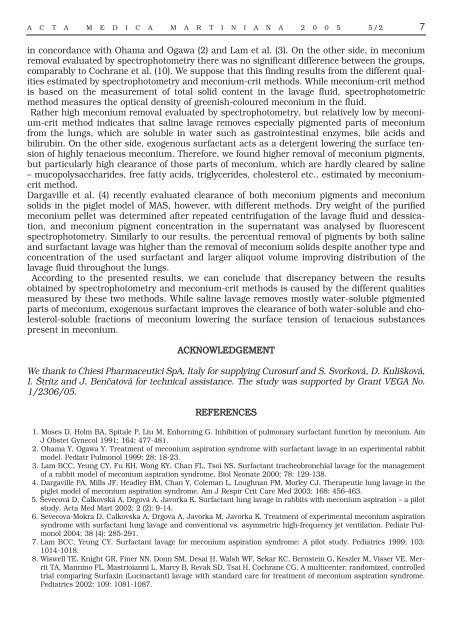MAKETA 5/2 po
MAKETA 5/2 po
MAKETA 5/2 po
Create successful ePaper yourself
Turn your PDF publications into a flip-book with our unique Google optimized e-Paper software.
A C T A M E D I C A M A R T I N I A N A 2 0 0 5 5/2 7<br />
in concordance with Ohama and Ogawa (2) and Lam et al. (3). On the other side, in meconium<br />
removal evaluated by spectrophotometry there was no significant difference between the groups,<br />
comparably to Cochrane et al. (10). We sup<strong>po</strong>se that this finding results from the different qualities<br />
estimated by spectrophotometry and meconium-crit methods. While meconium-crit method<br />
is based on the measurement of total solid content in the lavage fluid, spectrophotometric<br />
method measures the optical density of greenish-coloured meconium in the fluid.<br />
Rather high meconium removal evaluated by spectrophotometry, but relatively low by meconium-crit<br />
method indicates that saline lavage removes especially pigmented parts of meconium<br />
from the lungs, which are soluble in water such as gastrointestinal enzymes, bile acids and<br />
bilirubin. On the other side, exogenous surfactant acts as a detergent lowering the surface tension<br />
of highly tenacious meconium. Therefore, we found higher removal of meconium pigments,<br />
but particularly high clearance of those parts of meconium, which are hardly cleared by saline<br />
– muco<strong>po</strong>lysaccharides, free fatty acids, triglycerides, cholesterol etc., estimated by meconiumcrit<br />
method.<br />
Dargaville et al. (4) recently evaluated clearance of both meconium pigments and meconium<br />
solids in the piglet model of MAS, however, with different methods. Dry weight of the purified<br />
meconium pellet was determined after repeated centrifugation of the lavage fluid and dessication,<br />
and meconium pigment concentration in the supernatant was analysed by fluorescent<br />
spectrophotometry. Similarly to our results, the percentual removal of pigments by both saline<br />
and surfactant lavage was higher than the removal of meconium solids despite another type and<br />
concentration of the used surfactant and larger aliquot volume improving distribution of the<br />
lavage fluid throughout the lungs.<br />
According to the presented results, we can conclude that discrepancy between the results<br />
obtained by spectrophotometry and meconium-crit methods is caused by the different qualities<br />
measured by these two methods. While saline lavage removes mostly water-soluble pigmented<br />
parts of meconium, exogenous surfactant improves the clearance of both water-soluble and cholesterol-soluble<br />
fractions of meconium lowering the surface tension of tenacious substances<br />
present in meconium.<br />
ACKNOWLEDGEMENT<br />
We thank to Chiesi Pharmaceutici SpA, Italy for supplying Curosurf and S. Svorková, D. Kulišková,<br />
I. Štritz and J. Benčatová for technical assistance. The study was sup<strong>po</strong>rted by Grant VEGA No.<br />
1/2306/05.<br />
REFERENCES<br />
1. Moses D, Holm BA, Spitale P, Liu M, Enhorning G. Inhibition of pulmonary surfactant function by meconium. Am<br />
J Obstet Gynecol 1991; 164: 477-481.<br />
2. Ohama Y, Ogawa Y. Treatment of meconium aspiration syndrome with surfactant lavage in an experimental rabbit<br />
model. Pediatr Pulmonol 1999; 28: 18-23.<br />
3. Lam BCC, Yeung CY, Fu KH, Wong KY, Chan FL, Tsoi NS. Surfactant tracheobronchial lavage for the management<br />
of a rabbit model of meconium aspiration syndrome. Biol Neonate 2000; 78: 129-138.<br />
4. Dargaville PA, Mills JF, Headley BM, Chan Y, Coleman L, Loughnan PM, Morley CJ. Therapeutic lung lavage in the<br />
piglet model of meconium aspiration syndrome. Am J Respir Crit Care Med 2003; 168: 456-463.<br />
5. Ševecová D, Čalkovská A, Drgová A, Javorka K. Surfactant lung lavage in rabbits with meconium aspiration – a pilot<br />
study. Acta Med Mart 2002; 2 (2): 9-14.<br />
6. Sevecova-Mokra D, Calkovska A, Drgova A, Javorka M, Javorka K. Treatment of experimental meconium aspiration<br />
syndrome with surfactant lung lavage and conventional vs. asymmetric high-frequency jet ventilation. Pediatr Pulmonol<br />
2004; 38 (4): 285-291.<br />
7. Lam BCC, Yeung CY. Surfactant lavage for meconium aspiration syndrome: A pilot study. Pediatrics 1999; 103:<br />
1014-1018.<br />
8. Wiswell TE, Knight GR, Finer NN, Donn SM, Desai H, Walsh WF, Sekar KC, Bernstein G, Keszler M, Visser VE, Merrit<br />
TA, Mannino FL, Mastrioianni L, Marcy B, Revak SD, Tsai H, Cochrane CG. A multicenter, randomized, controlled<br />
trial comparing Surfaxin (Lucinactant) lavage with standard care for treatment of meconium aspiration syndrome.<br />
Pediatrics 2002; 109: 1081-1087.

















